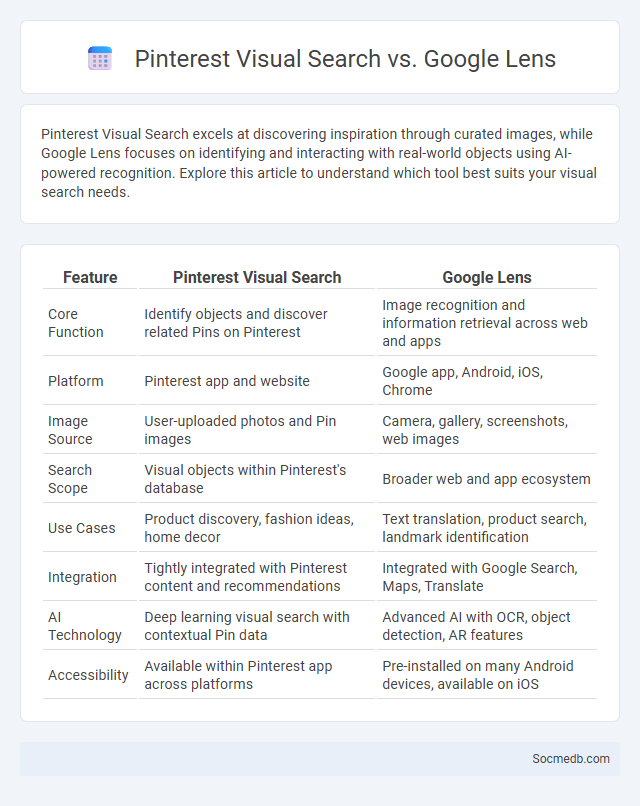
Photo illustration: Pinterest Visual Search vs Google Lens
Pinterest Visual Search excels at discovering inspiration through curated images, while Google Lens focuses on identifying and interacting with real-world objects using AI-powered recognition. Explore this article to understand which tool best suits your visual search needs.
Table of Comparison
| Feature | Pinterest Visual Search | Google Lens |
|---|---|---|
| Core Function | Identify objects and discover related Pins on Pinterest | Image recognition and information retrieval across web and apps |
| Platform | Pinterest app and website | Google app, Android, iOS, Chrome |
| Image Source | User-uploaded photos and Pin images | Camera, gallery, screenshots, web images |
| Search Scope | Visual objects within Pinterest's database | Broader web and app ecosystem |
| Use Cases | Product discovery, fashion ideas, home decor | Text translation, product search, landmark identification |
| Integration | Tightly integrated with Pinterest content and recommendations | Integrated with Google Search, Maps, Translate |
| AI Technology | Deep learning visual search with contextual Pin data | Advanced AI with OCR, object detection, AR features |
| Accessibility | Available within Pinterest app across platforms | Pre-installed on many Android devices, available on iOS |
Introduction to Visual Search Technologies
Visual search technologies enable users to find content by uploading images instead of typing keywords, revolutionizing social media interaction. Platforms like Pinterest and Instagram utilize AI-powered algorithms to analyze visual elements, allowing Your searches to yield highly relevant and personalized results. Leveraging deep learning and computer vision, these technologies enhance user engagement by simplifying the discovery of products, trends, and similar images within social networks.
Understanding Pinterest Visual Search
Pinterest Visual Search leverages advanced image recognition technology to identify objects within pins, enabling users to discover similar items or related content effortlessly. This feature enhances user engagement by allowing seamless exploration of products, styles, or ideas directly from images without needing text-based queries. The integration of AI-driven visual search on Pinterest significantly boosts e-commerce opportunities by connecting users with shoppable products based on visual elements.
Exploring Google Lens Features
Google Lens revolutionizes visual search by enabling users to identify objects, landmarks, and text through their smartphone cameras. Its features include real-time translation, shopping suggestions, and plant or animal identification, enhancing social media interactions with enriched content discovery. Integration with platforms like Google Photos and Instagram allows seamless sharing of contextual information, boosting user engagement and content relevance.
Overview of General Visual Search Tools
Visual search tools leverage artificial intelligence and machine learning algorithms to analyze images and provide relevant results based on visual content rather than keywords. Platforms like Google Lens, Pinterest Lens, and Bing Visual Search enable users to discover products, landmarks, and information by simply uploading or snapping a photo. These tools enhance user engagement on social media by facilitating seamless interaction between visual content and search functionalities.
Accuracy and Effectiveness Comparison
Accuracy and effectiveness in social media marketing directly impact campaign success and audience engagement. Platforms like Facebook and Instagram offer advanced targeting tools that enhance message precision, while Twitter emphasizes timely interactions for real-time engagement. Analyzing key performance indicators such as click-through rates and conversion metrics helps optimize strategies for better accuracy and overall effectiveness.
User Experience and Interface Differences
Social media platforms prioritize user experience (UX) by implementing intuitive interfaces tailored to specific user behaviors, such as Instagram's emphasis on visual content through streamlined photo browsing and Snapchat's ephemeral messaging features. Interface differences are evident in navigation design, with Facebook offering comprehensive menu options for diverse functionalities, while TikTok uses a minimalist vertical feed to maximize content consumption. These UX and UI choices directly impact user engagement, retention rates, and content interaction patterns across various social media networks.
Use Cases and Application Scenarios
Social media platforms enable businesses to engage directly with customers, boosting brand awareness and driving sales through targeted advertising and personalized content. Influencers leverage social media to build trust and reach niche audiences, enhancing marketing efforts across industries such as fashion, technology, and fitness. Your ability to analyze user behavior data helps optimize campaigns, improve customer service, and foster community growth in diverse sectors including education, healthcare, and entertainment.
Integration with Other Platforms
Social media platforms increasingly integrate with e-commerce sites, CRM systems, and content management tools to streamline user experiences and data sharing. APIs enable seamless cross-platform functionality, allowing businesses to automate marketing campaigns and enhance customer engagement. This integration boosts efficiency by consolidating analytics and facilitating multi-channel communication strategies.
Privacy and Data Handling Concerns
Social media platforms often collect extensive personal data, raising significant privacy concerns for users. Many companies implement complex data handling practices that can obscure how information is used, shared, or sold to third parties. Users must remain vigilant about privacy settings and informed consent to protect their digital identities and personal information from unauthorized access or misuse.
Future Trends in Visual Search Technology
Visual search technology is rapidly evolving, leveraging artificial intelligence and machine learning to enhance image recognition and object identification on social media platforms. Future trends include increased integration of augmented reality (AR) with visual search, enabling users to interact with physical objects in real time for shopping or information retrieval. Advancements in deep learning models will improve accuracy and personalization, transforming how users discover content and engage with brands visually.
 socmedb.com
socmedb.com